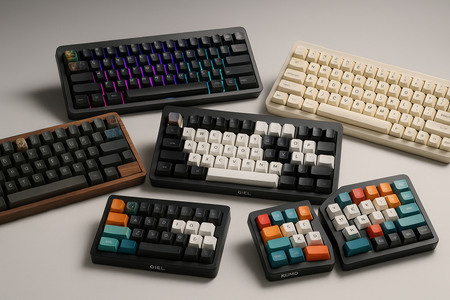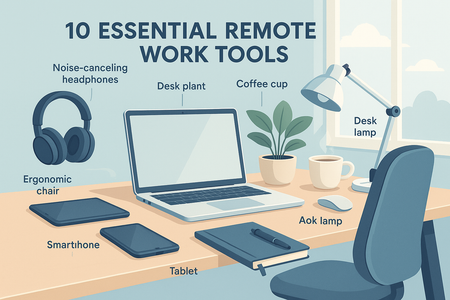Remote work has become more than just a temporary shift—it’s a lasting change that continues to redefine how and where we work. For many professionals, a home office is no longer a second-rate alternative but a primary workspace equipped with cutting-edge gadgets and software. As we explore smart tech for WFH, we’ll see how everything from automated lighting systems to advanced collaboration platforms is revolutionizing the remote work experience. In this guide, you’ll discover the essential tools, security considerations, and real-world applications that highlight the exciting potential of modern work from home setups.
Introduction: The Rise of Remote Work & The Role of Smart Tech
Even before global events accelerated the shift to remote work, digital nomads and freelancers were adopting flexible, location-independent careers. This transformation has only gained momentum, thanks to breakthroughs in cloud computing, high-speed internet access, and user-friendly productivity tools.
But as remote work becomes the norm for a wide range of industries—technology, marketing, consulting, and more—professionals are seeking creative solutions to replicate or even surpass the comfort and efficiency of a traditional office. That’s where smart home office gadgets and remote work automation enter the picture, making it easier than ever to stay focused, collaborate with colleagues, and maintain work-life balance in a home environment.
Why It Matters:
-
Enhanced Productivity: The right setup can eliminate distractions and boost performance.
-
Greater Comfort: Ergonomics, ambient lighting, and automated systems reduce strain, fatigue, and daily friction.
-
Future-Proofing: As more companies embrace hybrid or fully remote models, a tech-forward office ensures you won’t lag behind evolving workplace standards.
Smart Hardware Essentials
The foundation of any modern work from home setup lies in well-chosen hardware. While laptops and smartphones are a given, contemporary remote work increasingly depends on an ecosystem of integrated, productivity tools for home offices that leverage IoT, AI, and automation.
1. Ergonomic & Automated Desks
Gone are the days when you had to manually crank a standing desk into place. Motorized, app-controlled desks like the Fully Jarvis or Uplift Desk let you switch from sitting to standing at the push of a button—or even on a preset schedule.
-
Benefits: Improved posture, reduced sedentary time, better energy levels.
-
Automation Potential: Some models sync with health apps to remind you when to stand or take breaks.
2. AI-Driven Lighting Systems
A well-lit workspace can dramatically impact mood and focus. Smart tech for WFH includes adaptive lighting setups—like the Philips Hue or Nanoleaf lines—that adjust color temperature throughout the day or respond to voice commands.
-
Use Cases: Bright, cool lighting to boost alertness during morning calls; dimmer, warmer tones for late-night planning sessions.
-
Integration: Tie your lights into a broader automation routine. For instance, lights can gradually brighten for a gentle morning wake-up or switch off automatically when you end your workday.
3. Intelligent Climate Control
Devices like the Nest Learning Thermostat or Ecobee systems do more than just keep your space comfortable. They optimize energy usage based on your schedule, potentially saving costs and providing a healthier environment for prolonged work sessions.
-
Key Features: Remote control via smartphone, adaptive algorithms that learn your preferences, humidity sensors.
-
Bonus: Some systems integrate with voice assistants, enabling temperature changes through simple spoken commands.
4. Advanced Audio & Video Equipment
High-quality audio and video aren’t just for creative professionals anymore. Video conferencing tools have become mainstays of remote collaboration, making crisp audio and sharp video essential.
-
Recommended Devices:
-
Microphones: Blue Yeti, Rode NT-USB
-
Webcams: Logitech Brio 4K, Razer Kiyo Pro
-
Headsets: Bose Noise Cancelling Headphones 700, Sony WH-1000XM4
-
Automation Angle: Some advanced microphones auto-adjust gain or noise suppression depending on your environment. Cameras can offer automatic frame-centering to keep you in focus during calls.
5. Automated Desk Gadgets
Small gadgets, big impact. Consider a Bluetooth-enabled coffee mug that maintains temperature or a smart pen that digitizes notes in real-time. Although these extras might seem minor, they can significantly streamline daily workflows.
Tip: For a deeper dive into device-specific recommendations, see our Top 5 Office Automation Gadgets to learn how these items can supercharge your WFH experience.
Software & Collaboration Tools
As crucial as hardware can be, remote work automation and productivity often hinge on the right software ecosystem. From team communication to project management, various applications keep a dispersed workforce in sync.
1. Video Conferencing & Communication
-
Zoom / Microsoft Teams / Google Meet: Offer high-quality video and screen-sharing for team check-ins or client pitches.
-
Slack / Discord: Ideal for real-time messaging, file sharing, and even voice chats within specific channels.
-
AI-Powered Chatbots: Tools like Dialpad’s AI-driven meeting summaries help condense long discussions, ensuring no key detail is missed.
2. Project Management Platforms
-
Trello / Asana / Monday.com: Visual task boards, Gantt charts, and integrative dashboards keep teams aligned.
-
Automation Features: These platforms often sync with email or Slack, automating task updates and notifications.
3. Cloud Storage & Collaboration
-
Google Workspace / Microsoft 365: Real-time co-editing, advanced version control, and shared calendars help reduce back-and-forth emailing.
-
Dropbox / Box: Secure file sharing and advanced permissions ensure everyone has the latest project files.
-
Cloud Automation: Tools like Zapier or IFTTT can link different cloud services, automating repetitive tasks (e.g., saving email attachments to a specific folder).
Further Reading: Our Beginner’s Guide to Smart Devices explores how these cloud-based tools integrate with voice assistants and other IoT systems to create an even more cohesive workflow.
Security & Privacy in a Smart WFH Setup
Embracing smart home office gadgets and cloud platforms also comes with responsibilities—particularly around data security. As you connect more devices to your network, potential vulnerabilities can grow.
Best Practices
-
Update Firmware & Software: Regular updates close security loopholes in IoT devices.
-
Use Strong, Unique Passwords: Avoid reusing passwords across multiple platforms; opt for a password manager.
-
Network Segmentation: Create separate Wi-Fi networks for work and personal use. Some advanced routers support “guest” or “IoT” networks.
-
Enable Two-Factor Authentication: Whenever available, 2FA adds an extra layer of security for remote access to systems.
Data Privacy Concerns
-
Voice Assistants: Smart speakers and voice assistants can inadvertently record snippets of conversation. Learn and manage privacy settings to limit data collection.
-
Video Conferencing: Tools like Zoom have faced scrutiny for encryption practices. Ensure you adjust settings for maximum privacy (e.g., password-protected meetings, waiting rooms).
External Reference: The Cybersecurity and Infrastructure Security Agency (CISA) provides guidelines for remote workers, including ways to reduce risk when using personal devices and cloud-based services.
Case Studies & Real-Life Examples
1. The Solo Freelancer
Situation: A freelance web developer wanted to boost focus and reduce distractions.
Setup:
-
A motorized standing desk with integrated cable management.
-
Smart lights set to switch between a “Morning Focus” scene and an “Afternoon Calm” scene.
-
Voice assistant handling meeting reminders and client follow-up prompts.
Outcome: Reported a 25% increase in daily tasks completed, fewer neck and back pain complaints, and an improved sense of daily rhythm.
2. The Creative Collective
Situation: A small design agency decided to go fully remote, with each member working from their own home studios.
Setup:
-
Shared Slack channels and Monday.com boards for project timelines.
-
Multi-party video conferencing through Zoom, with each user employing high-end webcams and ring lights for professional clarity.
-
AI-driven color temperature adjustments in each workspace for better color fidelity when reviewing client designs.
Outcome: Collaboration remained efficient, and clients appreciated the consistent professionalism, while each designer enjoyed the freedom to customize their environment.
3. The Minimalist Consultant
Situation: A business consultant who travels frequently needed a minimalist but robust home office for times between trips.
Setup:
-
One versatile laptop with a dock connected to dual 4K monitors.
-
A single smart speaker (Amazon Echo) for voice commands to manage tasks, check flights, and control lighting.
-
Security cameras and sensors integrated for remote monitoring, ensuring safe package deliveries while away.
Outcome: The consultant could pack up at a moment’s notice, while returning home to an instantly reactivated workspace with minimal fuss.
Conclusion: The Future is Bright for Smart Remote Work
Whether you’re writing code, producing creative content, or managing virtual teams, smart tech for WFH provides a new layer of convenience and efficiency. By thoughtfully selecting devices—from AI-driven desks and lighting to integrated collaboration software—you can create a modern work from home setup that’s comfortable, secure, and tailored to your unique workflow.
Key Takeaways:
-
Start small with essential hardware (e.g., a motorized desk, a quality webcam) and scale as you learn your preferences.
-
Integrate software tools that align with your daily tasks, ensuring easy collaboration and file management.
-
Prioritize security by segmenting networks, updating firmware, and activating strong authentication measures.
As remote work continues to evolve, the interplay between smart home office gadgets and robust productivity apps will only deepen. Embrace this synergy, and you’ll discover a workspace that not only meets but enhances your professional ambitions—no matter where you are in the world.
Call to Action: Ready to elevate your home office? Explore the latest in IoT devices and automation tools, and don’t forget to check out expert resources like Advanced Home Automation Hacks for step-by-step guidance on creating a truly cutting-edge environment.






0 comments